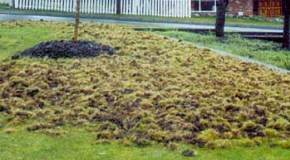 European Chafer Beetle
European Chafer Beetle

Adult European Chafer beetles are tan or brown beetles resembling June beetles but measure only about 1.5cm in length. The grubs, measuring 2 to 2.5 cm, are soft, white, and C-shaped with tan-coloured heads and six prominent legs.
Because this invasive species reproduces rapidly and feeds on the roots of all kinds of plants, including grass and turf used for lawns, it has become a serious pest in Vancouver and area. Health Bylaw No. 9535 prohibits the use of neonicotinoid pesticides, such as Merit or Arena, to combat European Chafer beetles.
Why European Chafer beetles are a nuisance
They are a nuisance because the grubs feed on the roots of all kinds of different plants, including turf and grass, destroying the plants. Their life cycle is only one year long, which means that their population rapidly increases.
How to know if you have an infestation
- Heavy infestations may lead to your grass feeling "spongy" due to the grubs tunneling below.
- Infested turf will commonly be wilted or dead and be easy to pull back, revealing the feeding larvae.
- Damage is seen in the fall to early spring when the grubs are full-grown. Grubs will feed all throughout the winter until they pupate in May.
- The damage these beetles cause can be masked by abundant moisture in spring and fall, but drier weather quickly results in the appearance of brown patches on your grass.
- You may also see birds, skunks, and other predators digging up your lawn in search of grubs.
Monitor your lawn for infestations
Take the following steps to monitor your lawn for infestations:
- Cut the sides of a 30 by 30 cm square of sod to a depth of 5 cm in five sections per lawn.
- Fold each square back and dig through the soil between the grass.
- Count the number of grubs. If you find more than 5-10 grubs per section, you may have an infestation to treat.
How to prevent infestations
Keep your turf healthy. Also, adopt a vigorous maintenance routine involving aerating, dethatching, fertilizing, deep watering, and mowing.
In high traffic areas consider grass replacements such as mulch or paving stones, or use alternative ground covers.
Treat Chafer beetle infestations naturally
During the third week of July, complete these steps to treat the infestation:
- Buy nematodes (Heterorhabditis bacteriophora) from your local lawn and garden store. Make sure to keep them refrigerated until the application day – these are living organisms.
- Moisten your lawn well (to the consistency of a wrung-out sponge).
- Apply nematodes on your lawn at a rate of approximately 50 million nematodes per 139 square metres (1500 square feet). This should cover a 33 x 45 foot lawn. Water the lawn again after the application to push the nematodes into the soil.
- Keep the soil moist for two to three weeks after applying the nematodes to ensure best results. This can be done within your lawn watering restrictions.
You may wish to purchase a water exemption permit to allow for additional sprinkling days. Please note the exemption permit allows for sprinkling between the hours of 4:00am – 9:00am only.
The City of Vancouver does not allow pesticides or chemicals such as Merit or Arena to treat chafer beetles, as per Health Bylaw No. 9535.